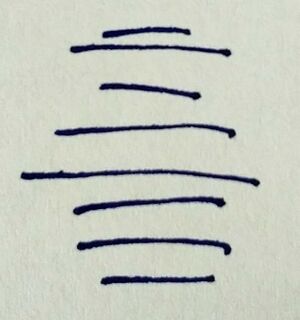Stacked fractions: Difference between revisions
From Why start at x, y, z
No edit summary |
No edit summary |
||
| Line 5: | Line 5: | ||
Things get even worse when you use the letter \(\Xi\) in this convoluted example: | Things get even worse when you use the letter \(\Xi\) in this convoluted example: | ||
\ | [[File:Xi bar over Xi .jpg|thumb|center|alt=A handwritten stacked fraction with Xi bar divided by Xi. In effect it looks like nothing more than a stack of eight horizontal lines of varying sizes.|\(\frac{\bar \Xi}{\Xi}\), handwritten]] | ||
Revision as of 13:12, 30 June 2021
A fraction written on multiple levels is often ambiguous, especially when handwritten. For example, \(\frac{10}{\frac{2}{5}}\) and \(\frac{\frac{10}{2}}{5}\) result in 25 and 1, respectively.
Things get even worse when you use the letter \(\Xi\) in this convoluted example:
